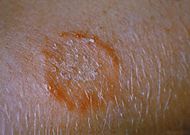Ringworm
| Ringworm Classification and external resources |
|
 |
|
|---|---|
| Ringworm on the arm | |
| ICD-10 | B35.4 |
| ICD-9 | 110.9 |
| DiseasesDB | 17492 |
| eMedicine | emerg/592 |
| MeSH | D014005 |
Ringworm (also called serpigo) is an infection of the skin, characterized by a reddish to brownish raised or bumpy patch of skin that may be lighter in the centre, giving the appearance of a “ring.” It can exist anywhere on the body. Depending on its location, it is also known as tinea pedis or "athlete's foot" when on the feet, tinea cruris or "jock itch" when on the groin area, tinea corporis when on the body, where it is most commonly referred to as ringworm, or tinea capitis when on the scalp.[1] Contrary to its name, ringworm is not caused by a worm but by parasitic fungi (Dermatophytosis).
Fungi are organisms that survive by eating plant or animal material, those that cause parasitic infection (dermatophytes) feed on keratin, the material found in the outer layer of skin, hair, and nails. These fungi thrive best on skin that is moist, hot, and hidden from the light. Together with the other dermatophytosis, up to twenty percent of the population has one of these infections at any given moment.
Misdiagnosis and treatment of ringworm with a topical steroid can result in tinea incognito, a condition where rinworm fungus will grow without typical features like a distinctive raised border.
Contents |
Differential Diagnosis - What Ringworm Can Resembles
Ringworm can be mistaken for one of the following conditions: granuloma annulare, discoid lupus, and sarcoidosis. Bullous tinea pedis (athlete foot with blisters) can mimic bullous drug reactions, bullous pemphigoid, and other bullous diseases of the skin. If suspected ringworm does not respond to routine antifungal treatment, further diagnostics must be performed, like a skin biopsy, a fungal culture, or a skin scraping for fungus identification.
Prevention
Fungi thrive in moist, warm areas, such as locker rooms and swimming pools, and in skin folds. The fungi may be present without any symptoms.
Advice often given to prevent ringworm includes:
- Avoidance of sharing clothing, sports equipment, towels, or sheets.
- Washing clothes in hot water with fungicidal soap after suspected exposure to ringworm.
- Avoidance of walking barefoot, wearing of appropriate protective shoes to the beach and flip-flops/thongs in locker rooms.[2][3][4][4]
- After being exposed to places where the potential of being infected is great [5], washing with an antibacterial and anti-fungal soap or one that contains Tea Tree Oil, which contains terpinen-4-ol.
Diagnosis
See dermatophyte
With skin scraping and rapid microscopic identification with potassium hydroxide preparation.
With fungal culture and species identification. Might take 2 to 3 weeks for result.
With DTM (dermatophyte testing medium). Result will take from 7 to 14 days.[6]
Treatment
See dermatophyte
Topically with antifungal agents.
Systemically with oral medications, especially for scalp ring worm, or infection of the finger nails or toe nails.
See also
- Dermatophyte
- Folliculitis
- Pityriasis rosea
- Antifungal drug
References
- The Merck Manual, Twelfth Edition, 1972, p. 1451
Notes
- ↑ "MedicinePlus Medical Encyclopedia:Tinea Corporis". National Institues of Health. Retrieved on 2008-10-08.
- ↑ Keeping footloose on trips by Lori Klemm, podiatrist, Will County Medical Associates S.C. for The Herald News April 2 2008
- ↑ Fort Dodge Animal Health: Milestones from Wyeth.com. Accessed April 28, 2008
- ↑ 4.0 4.1 Ringworm In Your Dog Cat Or Other Pet: Prevention by Ron Hines DVM PhD 5/4/06. Accessed April 28, 2008
- ↑ InteliHealth:
- ↑ http://www.bd.com/ds/productCenter/299701.asp
External links
|
||||||||||||||||||||||||||||||||||
|
||||||||||||||||||||||||||